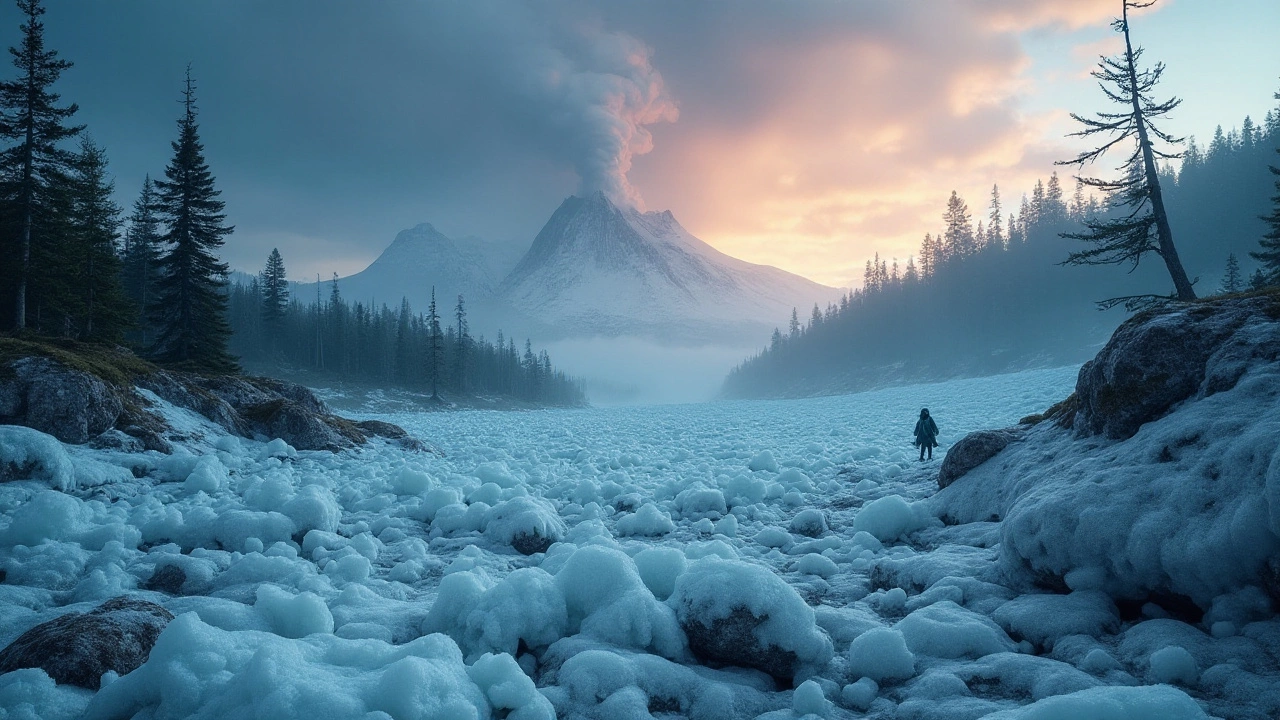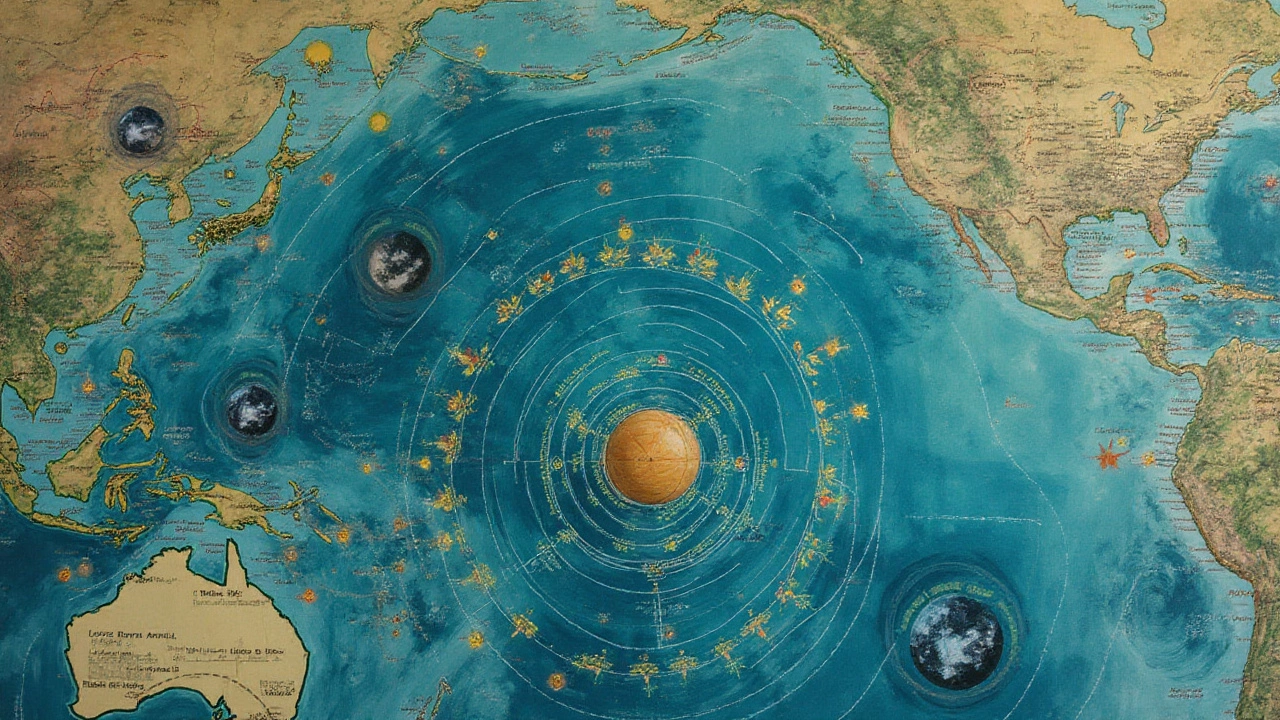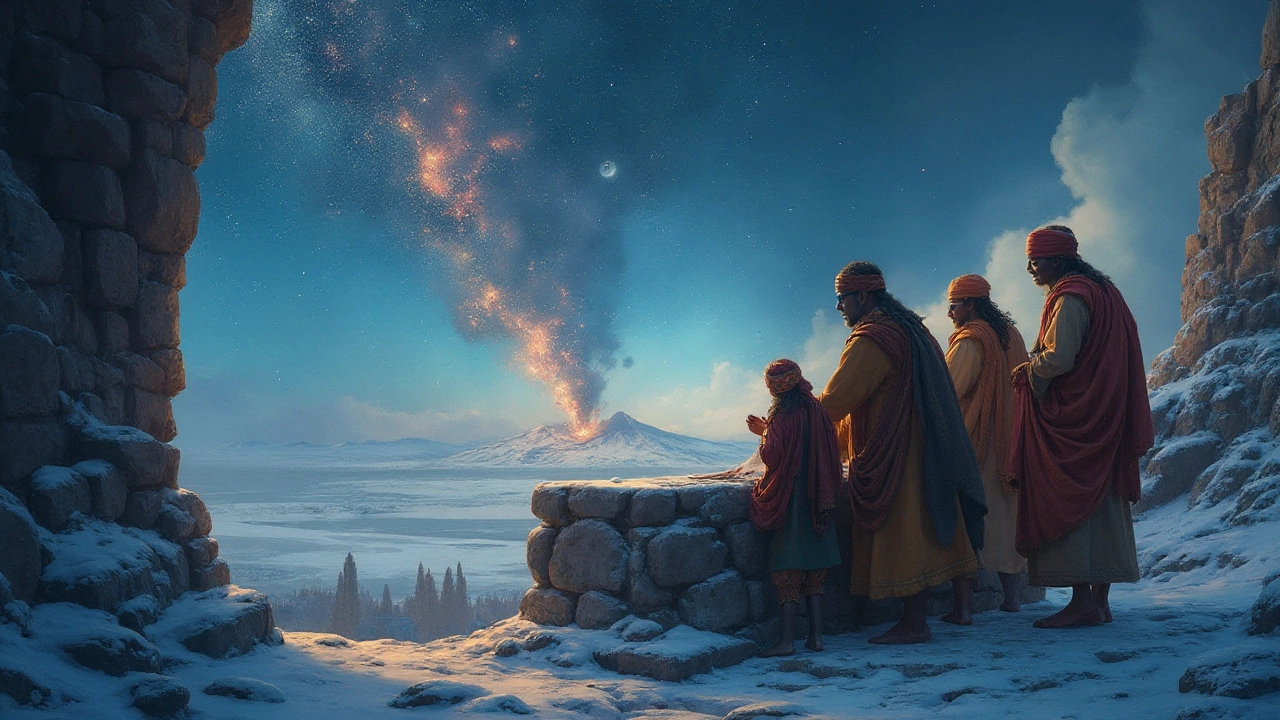Understanding Ice Age Triggers: Climate Change Insights
 Jan, 29 2025
Jan, 29 2025
Throughout Earth's history, our planet has witnessed cycles of extreme cold known as Ice Ages. These periods bring forth questions that have intrigued scientists for decades. What could trigger such drastic shifts in climate to plunge the Earth into icy darkness?
The causes of Ice Ages are deeply entrenched in the rhythms of our planet. From the dance of tectonic plates to wobbles in Earth’s orbit, several phenomena contribute to these huge changes. Volcanic eruptions spewing ash into the sky and deep ocean currents shifting their patterns are just some of the mysterious forces at play.
Remarkably, understanding these natural processes not only helps us in piecing together Earth's past but also sheds light on the factors affecting current climate trends. By piecing together clues from ancient ice and sediment, scientists strive to connect the dots between ancient times and modern climate concerns. Join us as we explore the fascinating triggers of Ice Ages and their significance for today's world.
- Historical Perspective of Ice Ages
- Natural Triggers Behind Ice Ages
- The Role of Earth's Orbit and Rotation
- Implications for Modern Climate Change
- Learning from the Past for Future Predictions
Historical Perspective of Ice Ages
Imagine a time when vast sheets of ice sculpted the landscape, carving out valleys and shaping mountains. These were the Ice Ages, periods where huge ice sheets enveloped the Earth, profoundly altering both the environment and life itself. To understand these icy epochs, one must delve into the depths of geological strata and unravel the ancient stories they tell. Evidence of past Ice Ages is found in rock formations, isotopic data from deep-sea cores, and patterns etched into the bedrock by retreating glaciers. These records collectively narrate a story that is both grand and humbling, speaking to the planet's dynamic nature.
The history of Ice Ages is marked by cycles, known as glacial and interglacial periods. These are not mere chapters of cold and warmth; each cycle spans tens of thousands of years. The last major Ice Age, known as the Pleistocene Epoch, began about 2.6 million years ago and officially ended around 11,700 years ago, transitioning into our current period, the Holocene. During these times, the Earth's climate underwent dramatic changes, and civilizations adapted continuously to survive and thrive in these shifting conditions. Historic glaciers advanced and retreated, acting as natural timekeepers through the ages.
To put it in context, the famed woolly mammoth roamed during these times, their massive herds grazing the tundra landscapes. Geological findings show that the thick ice sheets covered much of North America, Northern Europe, and Asia. These great ice sheets were colossal, sometimes stretching as far south as modern-day New York. Notably, the Bering Strait land bridge emerged during such glacial periods, providing a passage between Asia and North America for both animal migrations and early human settlers. This connection had profound implications for the human timeline and ecosystem dynamics.
"The hard data from Antarctica’s ice core is helping us understand that swift climate shifts during Ice Ages weren't isolated incidents but part of the planet's intricate dance," says Dr. Julian Scott from Columbia University's Climate Research Center.
Studying the history of Ice Ages isn't just about looking into the past; it's about drawing lessons for the future. As scientists meticulously trace back these periods, they aim to determine patterns that could enlighten us on current climate changes. The intricate relationship between natural forces and climatic output remains a major area of research, helping us comprehend Earth’s climatic behavior and its reactive nature to various triggers. As researchers decode clues and piece together this vast puzzle, they underscore the connectedness of Earth's history and our contemporary existence.
Natural Triggers Behind Ice Ages
Understanding the natural triggers of the Ice Age offers us a glimpse into the environmental changes that have shaped Earth. These periods of extreme chilling were not singular events but rather a series of complex interactions between Earth's systems. One of the primary drivers of these cold phases is volcanic activity. When volcanoes erupt, they release massive amounts of ash and gases into the atmosphere. This volcanic debris can increase atmospheric opacity, blocking sunlight and inducing global cooling. The infamous eruption of Tambora in 1815, which led to the "Year Without a Summer," is a more recent example of how volcanic activity can affect global temperatures, albeit on a less dramatic scale compared to full-blown Ice Ages.
Another significant factor in triggering Ice Ages is the change in ocean currents. The oceans act as vast conveyors of heat and moisture; their currents are primarily driven by differences in water temperature and salinity. During a global cooling phase, ice sheets grow and release fresh water into the oceans, disrupting the natural flow of currents. These disruptions can cause a domino effect, leading to cooler global temperatures and furthering ice sheet expansion. Scientists continue to study these oceanic patterns since they are crucial in understanding the Earth's climate history. Indeed, shifts in the North Atlantic Current have been associated with past climatic shifts, reinforcing the importance of the ocean in regulating climate.
The position and tilt of our planet also play an essential role in the onset of Ice Ages. This phenomenon, known as Milankovitch cycles, refers to the changes in Earth's orbit and axial tilt. Over thousands of years, our planet experiences variations in the shape of its orbit, from more circular to more elliptical, as well as subtle shifts in its tilt. These cycles impact the distribution and intensity of sunlight received by Earth, leading to significant changes in climate over millennia. Though we often perceive climate change as a contemporary issue, these insights remind us of the natural ebbs and flows that have always been part of Earth's climate story.
Research continues into how these natural triggers work in tandem. While we cannot experience the Ice Ages firsthand, the geological record—fossils, ice cores, and sediment layers—tells us the tale of profound climatic shifts. As Dr. Richard Alley, a noted geoscientist, once stated,
"The more we understand about natural climate change, the more we realize how crucial it is to understand human impacts on the climate system."His insight underscores the interconnectedness of Earth's historical climate patterns with modern climate research.
| Trigger | Description |
|---|---|
| Volcanic Activity | Releases ash and gases that increase atmospheric opacity, reducing sunlight. |
| Ocean Currents | Redistribution of heat due to the influx of fresh water affects global climate systems. |
| Earth's Orbit and Tilt | Variations in orbital paths and axial tilts alter sunlight distribution. |
By examining these natural processes and how they once plummeted Earth into icy epochs, we gather invaluable insights that enhance our understanding of current and future climate dynamics. The story of the Ice Age is not just one of cold, it's a complex narrative of interplay among powerful natural forces that continues to intrigue the world today.

The Role of Earth's Orbit and Rotation
When it comes to unraveling the mysteries behind the Ice Age, one cannot overlook the significant role played by Earth's orbit and rotation. These celestial dynamics, known as Milankovitch cycles, orchestrate the intricate dance of our planet around the Sun. Named after Serbian scientist Milutin Milankovitch, these cycles affect the amount of solar energy reaching Earth, thus influencing long-term climatic patterns. The cycles are primarily classified into three types: eccentricity, axial tilt, and precession. Each of these has a distinct influence, setting the stage for potential glacial periods.
Eccentricity's Impact
The eccentricity cycle refers to the shape of Earth's orbit around the Sun, which varies from more circular to elliptical over 100,000 years. During periods of high eccentricity, the difference in distance Earth travels from the Sun becomes significant, affecting the climate drastically. As Earth moves through its elliptical path, differences in solar radiation can contribute to cooling periods, potentially leading to an Ice Age. For instance, scientists studying ancient ice cores have noticed the correlation between eccentricity cycles and cold climate patterns that have led to significant glaciations.Axial Tilt's Influence
Axial tilt, or obliquity, describes the angle between Earth's rotational axis and its orbital plane, cycling from 22.1 to 24.5 degrees over approximately 41,000 years. This tilt determines the contrast between the seasons, affecting how sunlight is distributed across the planet. During times of decreased tilt, summers become cooler, which may prevent ice melting in higher latitudes, triggering the spread of ice sheets. Historical records point to periods of minimized axial tilt coinciding with expanded ice coverage, suggesting a pivotal connection to Ice Age formations.Precession's Subtle Shifts
The precession wave, taking around 26,000 years, results from the gradual wobble in Earth's axis. This affects the timing of the seasons in relation to Earth's distance from the Sun. Depending on whether Earth is closer during winter or summer months, known as perihelion and aphelion respectively, the severity of each season can alter significantly. These subtle shifts are crucial in understanding how once lush landscapes may have transformed into icy vistas over millennia. Historical analysis and computer models use these cycles to project past climatic conditions and ascertain their relevance to current climate change issues.Understanding these orbital parameters isn't just piecing together Earth's distant past; it's crucial for modeling future climate predictions. Scientists are keenly aware of how the Milankovitch cycles interplay with carbon dioxide levels and natural feedback mechanisms. As Earth navigates these astronomical phases, the compound effect with human-induced factors could prompt significant shifts in climate patterns. Researchers like Richard Alley often highlight the importance of these cycles.
"While Earth's orbit around the sun might not change overnight, the incremental shifts can set the stage for dramatic climate transformations," Alley remarks.Delving into the rhythms of the cosmos, these celestial dances teach us about resilience and adaptation in the face of profound climatic transformations.
Implications for Modern Climate Change
The ancient Ice Ages offer a stark reminder of Earth’s capability for dramatic climate shifts. Today, as we grapple with the ramifications of modern climate change, understanding these past events becomes more critical than ever. The patterns that drove Ice Ages are not just relics of history but also hold valuable lessons for our current environmental transformations. Examining how Earth's orbit and shifts in its axis, known as Milankovitch cycles, influenced those dramatic climate periods can shed light on ongoing changes. While today's phenomenon primarily centers around the rapid increase of greenhouse gases, there's merit in understanding how natural processes complement these changes.
Notably, the cooling effects of volcanic eruptions in history, which have been recorded to cool global temperatures temporarily by injecting aerosols into the stratosphere, help us quantify the potential impact of similar natural events today. For instance, the 1991 eruption of Mount Pinatubo caused a global temperature decline by around 0.6 degrees Celsius for a brief period. These historical contexts underscore the interaction between natural and anthropogenic factors in driving climate change. It's worth noting, however, that current shifts are happening at an unprecedented rate.
Observing the long-term cycles of Earth and the Ice Age triggers can "enhance our understanding of the climate system and improve predictions of future climate shifts," according to a leading climatologist from NOAA.
As we parse through ice core samples, which act like climate time capsules, they reveal CO2 levels across millennia. By comparing these with today’s data, we're shown the stark reality—current CO2 concentrations are the highest they've been in 800,000 years. This demands a re-evaluation of our policies on emissions and resource consumption. While glaciers covered large swathes of land during the Ice Age, today we face their rapid retreat, which contributes significantly to sea-level rise. If we don’t heed these historical lessons, we could face environments vastly altered, not by ice but by inundation.
Mitigating the impacts of current climate change requires a mix of cutting-edge technology and ancient wisdom. As scientists incorporate data from past global cooling phenomena into climate models, they can better predict potential future scenarios. These insights not only advance scientific understanding but also guide policy and innovation in developing sustainable solutions. Learning from the Ice Ages informs us about resilience, adaptability, and the importance of proactive measures in an unpredictable climate future.

Learning from the Past for Future Predictions
The ancient climate records, locked away in layers of ice and sediment, serve as invaluable guides to untangling the complexities of climate change today. By studying these indicators, scientists can decode the rhythmic patterns and sudden shifts that have marked our planet's tumultuous past. This understanding becomes a map, helping researchers to anticipate potential future climatic shifts and the triggers that could awaken them again. In the archival depths of Greenland and Antarctic ice cores, we find evidence of atmospheric compositions dating back millions of years. These ice cores are like time capsules, highlighting past cycles of warming and cooling that mirror the ebb and flow of the Ice Age epochs.
One particularly thrilling aspect of this research is identifying the triggers that could lead from a warm period back into an ice cap-dominated landscape. Changes in the Earth's orbit around the sun, combined with variations in axial tilt, can provoke major shifts in climate. Known as Milankovitch cycles, named after Serbian scientist Milutin Milankovitch, these alterations in our planet's movements impact the solar energy distribution received by Earth, causing glacial and interglacial transitions.
Given the energy stakes involved, it is crucial to study whether modern human activity might inadvertently influence these natural cycles. Increasing greenhouse gases may counteract natural cooling trends, but they also underscore the unpredictability of these ancient forces interacting with modern human-induced changes. Such an unpredictable future demands rigorous research and open dialogue, as scientists worldwide strive to collect and analyze old climate records. As renowned climatologist Dr. James Hansen once said,
"Understanding how climate worked in the past tells us how it could work in the future."Lessons drawn from these periods improve predictive models, helping policymakers craft informed plans for climate resilience.
Another critical element these data offer is the insight into ocean currents, especially the mighty Atlantic Meridional Overturning Circulation. This oceanic conveyor belt, driven by differences in ocean temperature and salinity, has a monumental influence on weather patterns around the world. By understanding how this circulation changed during the last Ice Age, climatologists can better predict potential disruptions. If this current were to slow down, drastic regional cooling could ensue, with extensive consequences for Europe's climate and beyond.
Predicting future climates from the past also involves understanding the role of volcanic activity. Massive eruptions have historically spewed another set of climatic clues, revealing their short-lived but powerful impacts. Consistent records from both small eruptions and the supervolcanic blasts chronicle times when the Earth shivered under a dust-shielded sun. Scientists utilize these insights to assess the potential impact of future eruptions, their extent, and how they might interplay with existing warming trends. It is this delicate balance between natural occurrences and human actions that forms the next phase of climatic inquiry, aiming to sculpt a future more attuned to natural rhythms.